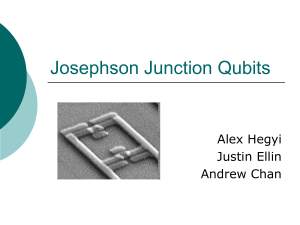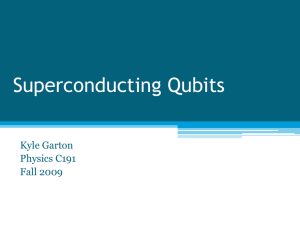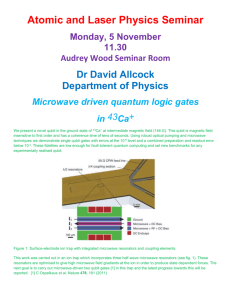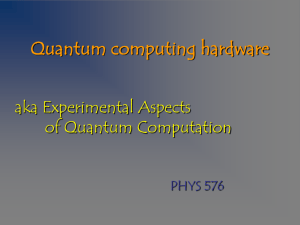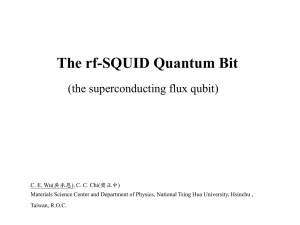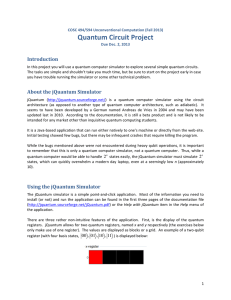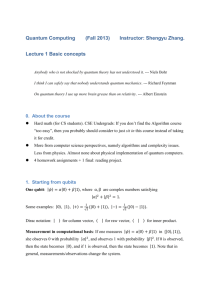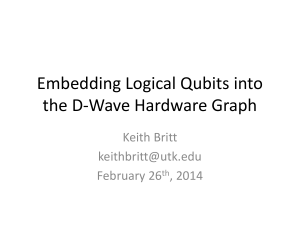here are the slides
advertisement
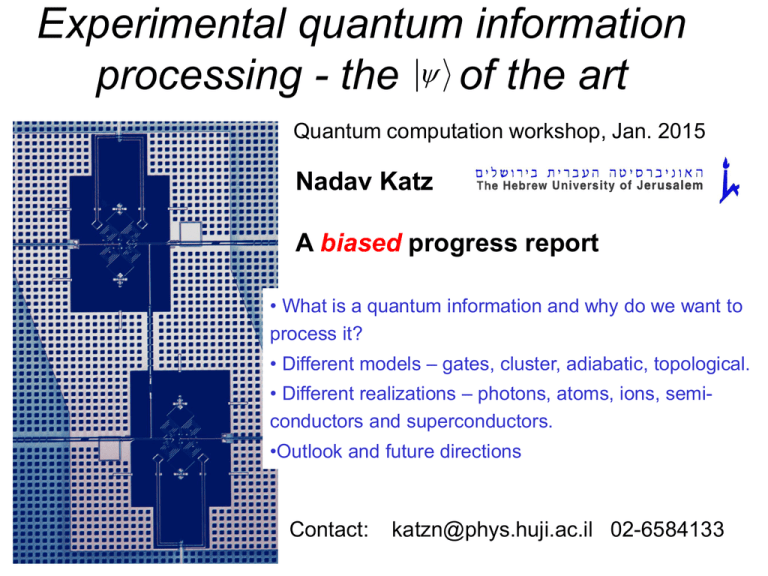
Experimental quantum information processing - the of the art Quantum computation workshop, Jan. 2015 Nadav Katz A biased progress report • What is a quantum information and why do we want to process it? • Different models – gates, cluster, adiabatic, topological. • Different realizations – photons, atoms, ions, semiconductors and superconductors. •Outlook and future directions Contact: katzn@phys.huji.ac.il 02-6584133 Motivation & Wait for one half-life 2 Single atom decays – cat dies! We NEVER see such macroscopic superpositions – why? Schrödinger: Aristotle: Nature abhors coherence a vacuum Dual/related problem (Feynman): exponential computational overhead for simulating many-body quantum systems Quantum Information Processing – • Practical advantages over classical info. ($$) • Relates to quantum phase transitions and computation complexity • How big a Schrödinger kitten can we build? Some comments about QC It is mainstream physics to assume it is possible with established error-correction codes (is nature malicious/ingenious?) Failure actually implies fundamentally new physics regarding decoherence (no evidence for this in known physics) QC is not magic: General/Generic unitary evolution of a many-body is still exponentially hard to simulate In the presence of symmetry and structure, sometimes dramatic speedup is predicted Storage of Information: Bits • Classical bit: definite 0 or 1 + 5V Vout • Quantum bits: superpose 0 or 1 Example: 0 1 H atom wavefunctions: Transistor Logic: 0 = 0 volts 1 = 5 volts 0 1 2 Bloch representation Geometrical picture: Useful for any two-level system Control: resonant (or close to resonant) pulses can be visualized as a rotation! Qubit Characterization 1 Rabi time Meas. x lifetime T1 ~450ns time Ramsey x/2 x/2 time Echo 0 1 x/2 y x/2 time Data from 2007… 0 1 T~100ns P1 0 1 T2 ~350ns 0 0 100 200 300 400 time [ns] 500 600 Entanglement Qubit 1 Qubit 2 Qubit 3 Qubit 4 • Require 2N complex numbers to specify a general N-qubit state! • Many (most actually) such states are not separable = entangled Classic 2-qubit example: Bell state Resource for secure communication (not discussed) 01 10 2 Such (anti-)correlations are normally generated by interactions (gates). Gate model Classical Computation: (DiVincenzo criteria) Quantum Computation: • Initialize state • Initialize state Yi = |000..0> • Logic • Logic via series of operations: not 0 -> 1 1 -> 0 and 00 -> 0 01 -> 0 10 -> 0 11 -> 1 |0> -> |1> |1> -> |0> |0> -> (|0>|1>)/21/2 State Manipulation (1 qubit) Controlled not (2 qubit) bit • Output result |00> -> |00> |10> -> |10> |01> -> |11> |11> -> |01> } + linear superposition control • Final state measurement Measure qubits of state Yf • Logic errors: Error correction possible • Coherence: tcoherence / tlogic ~ number logic operations > 102 for error correction Need to be clever When we measure – we want to see something interesting (and not some random, useless state out of 2N)… Well-known quantum computing algorithms: •Deutsch-Josza’s algorithm – find the parity of a function (exponentially fast!) •Shore’s algorithm – find the prime factors of a number (exponentially fast!) •Grover’s algorithm – check if a database contains an element (poly-faster) •These are famous, but there are some more (Eigenvalue estimation, random walk, Boson sampling hidden subgroup)… IMPORTANT: Error correction can make it work even if gates are not perfect! (Shor+many others…) Qubit progress From Devoret and Schoelkopf, Science (2013) Remarkable progress of the past 15 years Already passed the fault tolerant threshold Alternative computational models Cluster states Briegel & Raussendorf (2001) Generate a massively entangled initial state (c-not gates between nodes in graph, compute by measuring in a specific order) Single photons Knill, Leflamme, Milburn (2001) Using single photons (if you have them!) and linear optics – Scalable QIP is possible! Adiabatic Farhi (2001) Slowly evolve the Hamiltonian to remain in the ground state Topological Kitaev (1997) D-wave (??) Exponentially degenerate ground state (phases) with large gap. Braiding particles evolves the state. All are theoretically equivalent – but experimentally VERY different… Experimental Quantum Information Processing (QIP) a perplexing flora and fauna of different systems Quantum dots Neutral atoms ?? Quantum optics Josephson superconducting qubits Trapped ions NMR Experimental QIP – a guide for the perplexed Smaller Bigger Easier to isolate Harder to couple photons Ions Neutral Atoms NMR • Excellent single qubit • coupling hard… •Sinlge photon/graph states Easier to couple & construct Harder to isolate Semiconductor Spins Superconducting Quantum Dots and defects Circuits • Dots: LONG T1 and T2 • Coherent Oscillations • Coupling? • NMR: 2 to 7 qubits; scalability? • Ions: up to 14 qubits + scalable •Many technical issues still unsolved Goal - reach the fault tolerant threshold – F 99 % • Little dissipation • Reasonable coherence • Coupling • 9 qubits demonstrated Recent results Photons – 8 photon cluster states (2012) (Jian-Wei Pan group) Ions –99.93% fidelity of 1-qubit and 2-qubit gate demonstrated (Lucas group 2014): Coherent 14 and 6 ion states demonstated (Blatt/Wineland) Recent results – cont. Atoms – Mott insulator + controlled collisons + site addressing (Bloch group) Semiconductors – even denominator fractional Hall states demonstrated A possible model system for topological QIP. Heiblum group (2010) Recent results – cont (2). Superconductors – (1) surface code fault tolerance demonstrated (Martinis, 2013) (2) errors suppressed by logical qubits – for the first time! (Martinis 2014) Recent results – cont (2b). Superconductors – (2) errors suppressed by logical qubits – for the first time! (Martinis 2014) Recent results – cont (3). Superconductors – Circuit cavity electrodynamics Schoelkopf (2010) Simmonds (2007) Generation of Fock states up to N=16, with full state tomography Martinis (2010-2013), Katz (2013-2014) Outlook - hybrids Cavity – qubit interfaces will improve Yamamoto (2006-2008) Mechanical – qubit interfaces Kimbel (2008), Dayan (2014) Can we make a mechanical S-cat? Yes we can! Lehnert (2008-2013) Summary Exciting new computational models – better suited for implementation Experimental control/coherence of quantum systems is steadily growing Expect very exciting advances in the next decade…

